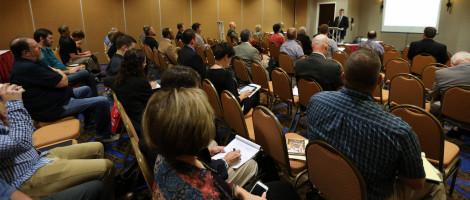The end of Religion? An Essential Corrective to the Secularization Myth
by Sheila Boggess on November 15, 2016 in Annual Meeting

Three scholars from Baylor University’s Institute for Studies of Religion (ISR) debunked the myth that the end of religion is near during an afternoon workshop on Monday at the Texas Baptists Annual Meeting in Waco.
The workshop drew close to 100 attendees as the three men gave their view of religion in today’s world.
Philip Jenkins, distinguished professor of history at Baylor and co-director for historical studies of religion in the Institute for Studies of Religion, said many look at Europe as a “godless Europe,” but nothing could be further from the truth.
“Europe is currently going through the greatest pilgrimage in its history,” Jenkins said.
Russia is in full revival, and Poland is seeing a record number of men becoming priests and women becoming nuns. Africans are playing a role in Europe as well. Jenkins said African pastors lead the four largest churches in Great Britain.
Jenkins introduced Rodney Stark, co-director for the Institute for Studies of Religion and distinguished professor of the social sciences at Baylor. Stark said the world “was never more religious than it is now.”
He said 81 percent of the world’s population belongs to a religious body, with Christianity growing the fastest. Yet atheism is at 5 percent. Islam is in decline.
“Church attendance has never been as high as it is now,” he added.
Africa has the largest Christian population in the world. Revival also is happening in India. Even though Russia required every child to have a regular class in atheism for the past 60 years, only six percent of Russians are atheists today.
Stark noted that China is leading the world’s revival. Two million Christians grew into 10 million, and though Stark said it is hard to know, he guesses China now has 100 million Christians. It won’t be long before China will have more Christians than anywhere.
“Christianity is not disappearing,” he added.
J. Gordon Melton, the author of Melton’s Encyclopedia of American Religions (8th edition, 2009) spoke next.
Melton is distinguished professor of American religious history of Baylor University’s Institute for Studies in Religion. In his decades of research, he said there are three basic kinds of religion: Affiliation (church membership), religious behavior (practice, attendance) and self-identification (how we think of ourselves).
Melton said that in 1800, only 15 percent of Americans were church members. By the middle of the century, despite tremendous growth, church membership was at 20 percent. It reached 30 percent by 1950.
“Not until World War II was 50 percent of the country Christian,” Melton said.
Locally in McLennan County, he found churches were under-reported. A survey showed 378 churches in the county, when in reality, there are 527 groups. He mentioned Homestead Heritage “was not on anyone’s radar,” and found that Spanish-speaking congregations were not being counted, either. To be sure, this under-reporting was not peculiar to the “Bible Belt.” He went to Washington state and reported on county similar in size to McLennan that had only 150 congregations reported. When his team looked, they found 100 new unreported categories.
Melton now is conducting a study in an urban area in Virginia to see if the trend continues. Their hypothesis is that more rural areas have more accurate numbers. As a result of this finding, Melton said the church is growing, but many are not being counted.
For more information, go to baylorisr.org.
Texas Baptists is a movement of God’s people to share Christ and show love by strengthening churches and ministers, engaging culture and connecting the nations to Jesus.
The ministry of the convention is made possible by giving through the Texas Baptists Cooperative Program, Mary Hill Davis Offering® for Texas Missions, Texas Baptists Worldwide and Texas Baptist Missions Foundation. Thank you for your faithful and generous support.
Subscribe to receive stories like this one directly to your inbox.
We are more together.